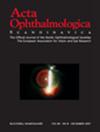Validation of the European visual field standards for driving: A driving simulator-based study
Abstract
Purpose
To determine whether we could establish evidence-based pass/fail criteria for perimetry in the context of the European visual field standards for driving.
Methods
This two-centre, cross-sectional study included participants with binocular visual field loss that had led to revocation of a group-1 driving licence. The participants underwent cognitive and binocular visual testing, including the European Driving Test (EDT), a perimetry algorithm that adheres to the European visual field standards. We used a high-fidelity driving simulator to compare the driving ability of these participants with healthy controls. Two driving instructors classified each driving test as passed or failed. Receiver operating characteristic (ROC) analysis and area under the curve (AUC) determined the ability of perimetry to discriminate between passed and failed driving tests.
Results
The study included 70 participants with visual field loss and 37 controls. A non-significantly higher proportion of controls passed the driving test (75% vs. 63%; p = 0.22). In ROC analysis, contrast sensitivity performed best (AUC of 0.73), followed by NEI VFQ-25 (AUC of 0.64). Peripheral visual field (AUC of 0.56) and central visual field (AUC of 0.47) performed weaker. Combining the central and peripheral visual field, and their interaction, increased AUC to 0.63.
Conclusion
Perimetry was a poor predictor of simulator-based driving test result, and we could not establish appropriate pass/fail criteria for the European visual field standards. Because perimetry is not an accurate diagnostic tool for fitness to drive, a practical driving assessment should be performed in case of doubt.


 求助内容:
求助内容: 应助结果提醒方式:
应助结果提醒方式:


